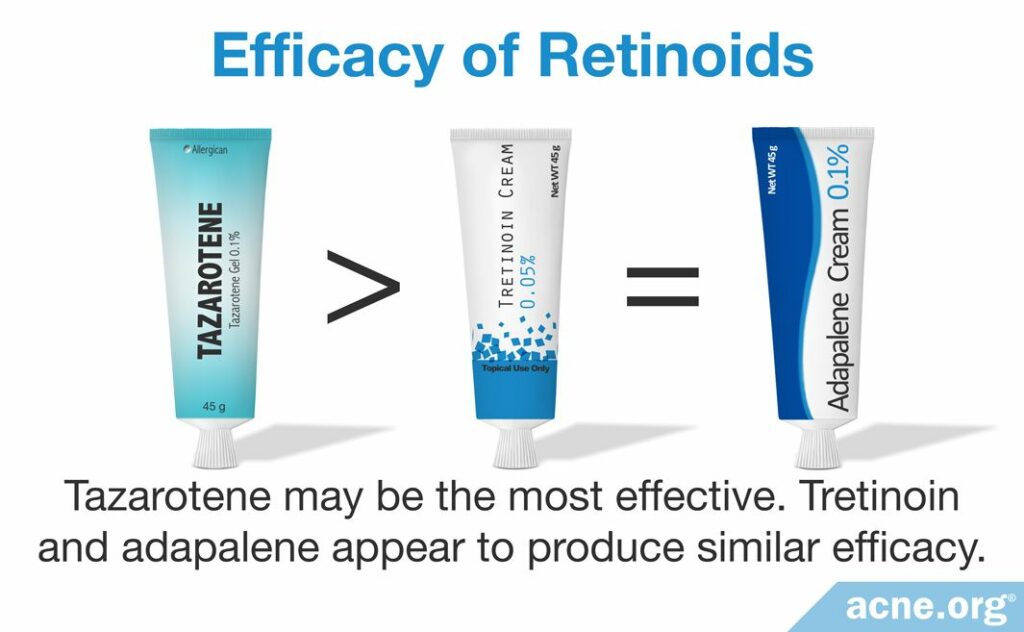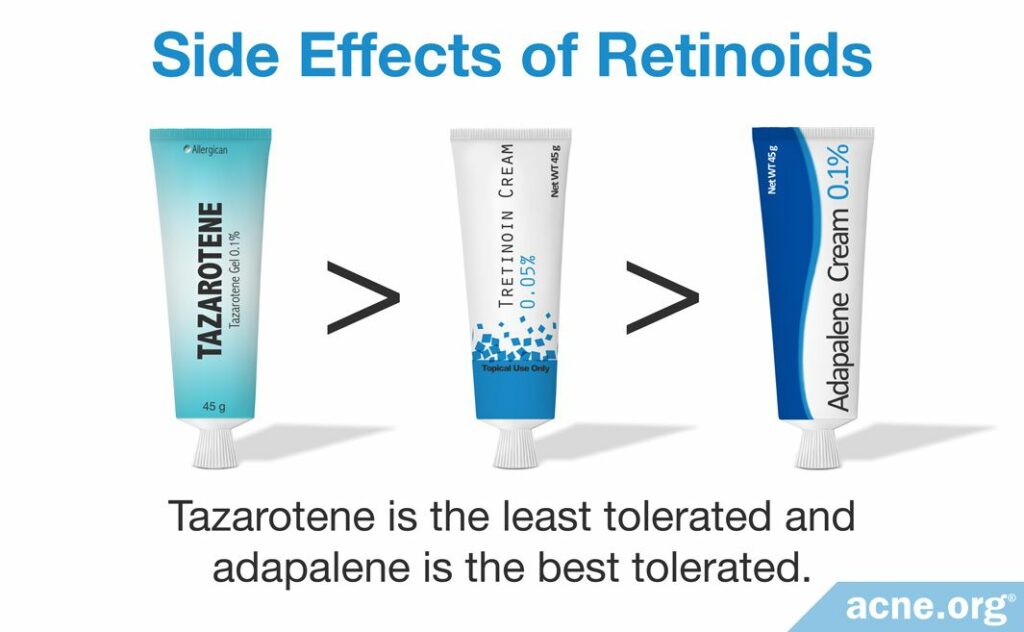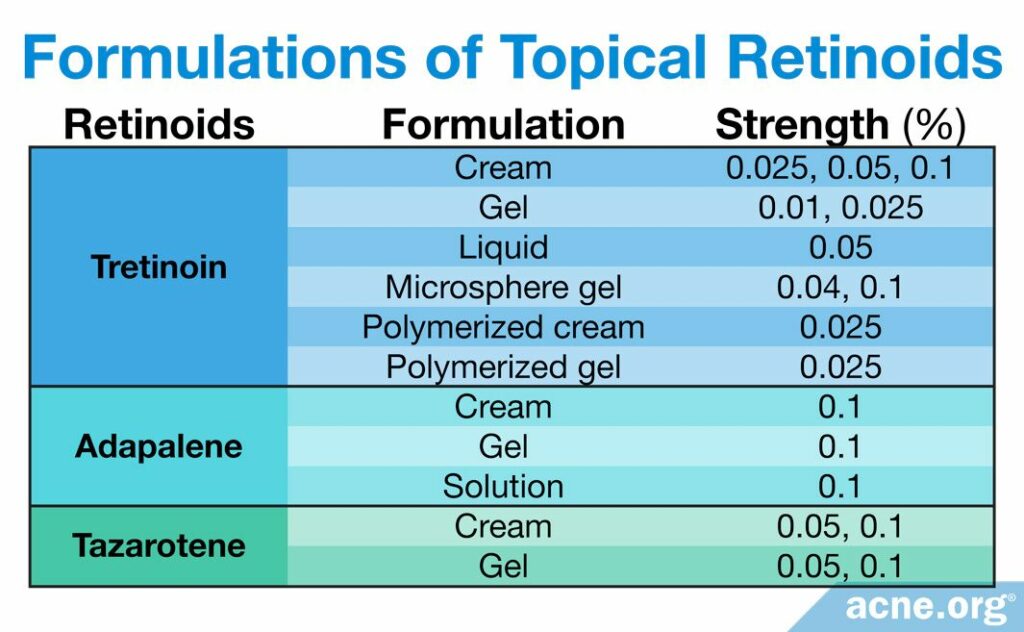Tazarotene May Produce Slightly Better Results, But Adapalene May Be Best When Side Effects Are Taken into Consideration

The Essential Info
There are three widely-available FDA-approved prescription topical retinoids on the market:
- Tretinoin
- Adapalene
- Tazarotene
Which One Is Most Effective Against Acne?
No studies have yet been performed directly comparing all three retinoids at once, so we can’t say for sure. But there have been several studies that compare two of them head-to-head, so here is our best educated guess based on the data so far:
Tazarotene may be very slightly more effective compared to Adapalene, and Adapalene may be similarly effective compared to Tretinoin.
Tazarotene > Adapalene = Tretinoin
The Winner: Tazarotene
What about Side Effects?
Tolerability is also very important when it comes to choosing a topical retinoid, and we get a different view of things when we look at topical retinoids from this lens:
Tazarotene comes with the most severe side effects, Tretinoin has less, and Adapalene has even less.
Tazarotene > Tretinoin > Adapalene
The Winner: Adapalene
The Takeaway: If you have normal or sensitive skin, adapalene might be the way to go. If you have tough skin that can withstand anything, Tazarotene might be worth a shot, but from what we can tell from studies, a majority of people find tazarotene’s side effects intolerable.

The Science
- Effectiveness of the Three Available Retinoids
- Comparing Efficacy
- Comparing Side Effects
- Effectiveness of Different Vehicles for Retinoids
- Takeaway
Topical retinoids are derivatives of vitamin A that treat mild-to-moderate acne. The first retinoid approved for patient use was tretinoin, which doctors began prescribing for the treatment of acne in 1971.1 Since then, scientists developed two additional retinoids in the 1990s, called adapalene and tazarotene, which are now also FDA-approved for acne treatment.2
A number of studies have been performed to examine that look at the effectiveness and side effects of tretinoin, adapalene, and tazarotene, so let’s have a look at what we can piece together.
Caution – Deep Science Ahead: To look at the topic of which retinoid is most effective and has the least side effects, we are going to get into details of a lot of studies. If you’re curious to get a “birds-eye-view” of this, just scroll through and look at the illustrations.
Effectiveness of the Three Available Retinoids

Retinoids are considered only partially effective against acne, which is why they are normally prescribed alongside other treatments. Overall, the research from several randomized controlled studies has concluded that all three retinoids reduce acne lesions by 40 – 70% in patients undergoing treatment for at least three months.3
Comparing Efficacy

Each of the three retinoids works via a slightly different mechanism in the skin by binding to different receptors in skin cells. As an article in the Journal of the American Academy of Dermatology states, these variances result in “slight differences in activity, tolerability, and efficacy.”4
Due to these slight differences, the FDA has approved different concentrations of each retinoid, as follows:
- Tretinoin: 0.025 – 0.1%
- Tazarotene: 0.05% – 0.1%
- Adapalene: 0.1% – 0.3%4
Since prescribed concentrations vary, this has limited researchers’ ability to definitively determine which retinoid is most effective. In addition, thus far there are no studies directly comparing all three medications at one time, so we are forced to piece together the available literature, which compares only two at a time. Let’s drill down into these studies and see what we can find. (Skip down to “Conclusion from these comparison studies” if you’d just like a quick summary.)
Tretinoin vs. Adapalene
Scientists have performed several studies comparing the effectiveness of tretinoin to that of adapalene. One large scientific review, which encompassed five controlled trials with a cumulative of over 900 patients, found that 0.1% adapalene gel is equally effective in reducing acne lesions as 0.025% tretinoin microsphere gel, 0.1% tretinoin gel, and 0.05% tretinoin cream. However, the scientists reported that the number of acne lesions decreased more quickly with adapalene treatment when compared to tretinoin treatment.5 Comparisons of effectiveness between tretinoin and adapalene are limited because conclusions from each study depend on the examined treatment concentration. For example, one study comparing the effectiveness of 0.1% adapalene gel to 0.05% tretinoin gel found that adapalene showed a “better therapeutic response,” while a separate study concluded that 0.3% adapalene and 0.3% tretinoin were “comparable in efficacy.”3,6 An additional study found patients responded faster with 0.1% tretinoin treatment than with 0.1% adapalene treatment, and that 0.1% adapalene and 0.025% tretinoin gels demonstrated equal effectiveness in reducing acne lesions.7 Comparing the above studies is difficult because they all examined different concentrations, so scientists have not yet been able to conclude whether adapalene or tretinoin is more effective in treating acne lesions. However, these studies do provide insight into the need for continued examination by scientists of the optimal concentration and treatment course so that an effective comparison can be made.
Tretinoin vs. Tazarotene
Unlike the comparison between tretinoin and adapalene, the scientific studies comparing the effectiveness of tretinoin to that of tazarotene are clear: tazarotene is more effective at reducing acne lesions. One study examining 169 patients who applied either 0.1% tazarotene or 0.1% tretinoin for 12 weeks found that tazarotene was more effective at reducing disease severity and non-inflammatory lesions like whiteheads and blackheads. When scientists compared tazarotene to tretinoin, they also found that tazarotene was more effective at reducing acne papules, pustules (pimples), and open comedones (blackheads), while both treatments displayed similar efficacy in the reduction of closed comedones (whiteheads).7 An additional study comparing 0.1% tazarotene to 0.025% and 0.1% tretinoin in 143 patients also concluded that tazarotene was more effective at reducing acne lesions.5
Adapalene vs. Tazarotene
Scientists have performed two studies comparing the effectiveness of adapalene to tazarotene. The first found that when patients applied each retinoid daily, the treatment resulted in “comparable efficacy in reducing inflammatory and [non-inflammatory] lesion counts.”7 The second study compared 0.1% adapalene to 0.1% tazarotene in 145 patients. The scientists concluded that tazarotene was more effective than 0.1% adapalene in the reduction of acne lesions.5 Due to these conflicting reports, more studies are needed before scientists can draw a conclusion about the comparable effectiveness of adapalene and tazarotene.
Conclusion from these comparison studies
From the information currently available, it appears that:
- Tazarotene may be slightly more effective than tretinoin.
- Tazarotene may be slightly more effective than adapalene.
- Tretinoin and adapalene may produce similar results.

A systematic review published in the American Journal of Clinical Dermatology in 2019 combed through 54 clinical trials on topical retinoids. The authors of the review found it difficult to rank the three topical, noting that differences in efficacy are likely minor. They wrote, “It is difficult to rank the various topical retinoids based on the limited number of comparative trials.” They also noted that choosing the right strength of medication may be even more important than choosing a particular retinoid. In general, the higher the concentration of a topical retinoid, the more effective it is against acne.8
In addition, researchers note that topical retinoids work especially well in tandem with benzoyl peroxide, so combining these two treatments into one regimen may yield even better results.8-10
Comparing Side Effects

Patients applying topical retinoids every day can experience side effects for the first two to three months of treatment. Common side effects include:
- Skin irritation
- Dryness
- Scaling
Generally, side effects appear within the first two to four weeks of treatment, but subside after two to three months of use.
One review compiled 34 independent studies to examine and compare side effects after tretinoin, adapalene, and tazarotene treatment. They found that all retinoids, regardless of concentration, induced some level of skin reaction during the first two to four weeks. Of the 13 studies that found a difference in tolerability between retinoids, the overall conclusion was that:
- Patients tolerated the 0.1% and 0.3% adapalene treatment best.
- Patients tolerated 0.1% tazarotene and 0.025% tretinoin treatment less than that of adapalene.
However, the other 21 studies examined in this review found no significant differences in tolerability between the topical retinoids, complicating the comparison.11
A smaller study examining the side effects of retinoid treatment on healthy patients concluded that tazarotene was the least tolerated of the three retinoids. This study examined 42 patients who applied varying concentrations and types of tretinoin, adapalene, and tazarotene to different skin patches on their bodies daily. Ninety percent of patients discontinued treatment of 0.05% and 0.1% tazarotene due to the development of side effects. In comparison, only one person discontinued use of the 0.1% adapalene gel, and no patients discontinued use of 0.1% adapalene solution. For tretinoin, 11 (26%) of the patients discontinued use of at least one of the three forms of tretinoin applied, with the 0.025% tretinoin gel being the most tolerated form.12 While this was a smaller study, it did compare the three retinoids directly, and thus we can count on the results.
Conclusion from side effect studies
Overall, the scientific literature suggests that patients tolerate adapalene treatment best, while tazarotene is by far the least tolerated of the three retinoids. However, the concentration and type (gel, cream, etc.) of retinoid applied does affect the intensity of side effects and tolerability of treatment, and therefore should be considered when retinoids are used to treat acne.
Effectiveness of Different Vehicles for Retinoids

The three available retinoids come in different vehicle formulations, such as gels and creams. Different vehicles provide for differing levels of reduction in acne lesions and intensity of side effects.
Tretinoin:
- Cream
- Gel
- Liquid
- Microsphere gel
- Polymerized cream
- Polymerized gel
- The newly created nanogel (not yet commercially available)
Adapalene:
- Gel
- Cream
- Solution
Tazarotene:
- Gel
- Cream
Unfortunately, scientists have been unable to perform extensive comparisons between the different vehicles because many manufacturers do not release their comparison data. However, because tretinoin comes in a variety of known formulations, scientists have been able to study and compare the effectiveness of different tretinoin formulations, which can give us a window, albeit narrow, into what vehicle might work best and which vehicle might have the lowest side effects.

Tretinoin microsphere gel vs. Tretinoin gel
In order to improve the tolerability of tretinoin gel, scientists generated microsphere gels, which slowly release tretinoin into the skin. To date, no studies have directly compared the efficacy of the microsphere gel to that of the traditional gel. However, studies independently investigating the effectiveness of microsphere gel have been consistent with results from previously performed studies using the traditional gel, suggesting that efficacy is similar between the two vehicles.13 Although not directly comparing the effectiveness between the two, another study combined data from previously performed research to evaluate and compare the microsphere gel and traditional gel. Using data from 483 patients treated with either the tretinoin microsphere gel or the traditional tretinoin gel for 12 weeks, the scientists concluded that both vehicles were equally effective at reducing acne lesions. However, patients receiving the traditional gel reported less side effect than those receiving the microsphere gel.
Tretinoin polymer vs. Tretinoin gel
Scientists developed the tretinoin polymer vehicle, like the tretinoin microsphere gel, to release tretinoin in a slow, controlled fashion in hopes that this would reduce skin irritation.13 One study comparing the effectiveness of the tretinoin polymer to that of the tretinoin gel found that when patients applied either formulation at a 0.025% concentration daily for 12 weeks, there were similar efficacy and side effects between the two. However, patients receiving the tretinoin polymer gel reported less peeling and dryness, even if the overall level of side effects was similar between the two groups.15
Tretinoin nanogel vs. Tretinoin gel
Scientists continue to develop new vehicles for retinoids in order to increase efficacy and decrease side effects. One of the newest vehicles to be developed is that of a tretinoin nanogel, which is not yet commercially available. One study compared the effectiveness and side effects of the tretinoin nanogel to those of the traditional tretinoin gel in 207 patients applying the retinoids daily for 12 weeks. Researchers found that the tretinoin nanogel caused a greater reduction in acne lesions when compared to the tretinoin gel (72.9% for the nanogel and 65% for the traditional gel). Patients receiving the nanogel also reported fewer side effects than patients receiving the traditional gel (13.3% for the nanogel and 24.7% for the traditional gel).1 It is important to keep in mind that these results, although promising, are from a single study, and therefore will need to be repeated before conclusions can be drawn. However, these early results suggest that the tretinoin nanogel is a promising new vehicle for tretinoin therapy that may be more effective and result in fewer side effects than the traditional tretinoin gel.
Takeaway
If you have normal or sensitive skin and are considering retinoid treatment, you may want to opt for adapalene. If your skin is very tough and you are one of those people who can withstand just about anything, tazarotene may ultimately be slightly more effective in reducing your acne, but be aware that even the toughest among us may find tazarotene to be challenging to handle for the first couple of months.
References
- Shapiro, S. et al. Use of topical tretinoin and the development of noncutaneous adverse events: Evidence from a systematic review of the literature. J Am Acad Dermatol 65, 1194 – 1201 (2011). https://www.ncbi.nlm.nih.gov/pubmed/21550137
- Hsu, P., Litman, G. I. & Brodell, R. T. Overview of the treatment of acne vulgaris with topical retinoids. Postgrad Med 123, 153 – 61 (2011). https://www.ncbi.nlm.nih.gov/pubmed/21566426
- Costa, C. S. & Bagatin, E. Evidence on acne therapy. Sao Paulo Med J 18, 193 – 197 (2013). https://www.ncbi.nlm.nih.gov/pubmed/23903269
- Zaenglein, A. L. et al. Guidelines of care for the management of acne vulgaris. J Am Acad Dermatol 74, 945 – 973 (2016). https://www.ncbi.nlm.nih.gov/pubmed/26897386
- Thielitz, A. et al. Topical retinoids in acne – an evidence-based overview. J Dtsch Dermatol Ges 6, 1023 – 1031 (2008). https://www.ncbi.nlm.nih.gov/pubmed/20482688
- Tirado-Sánchez, A. et al. Efficacy and safety of adapalene gel 0.1% and 0.3% and tretinoin gel 0.05% for acne vulgaris: Results of a single-center, randomized, double-blinded, placebo-controlled clinical trial on Mexican patients (skin type III-IV). J Cosmet Dermatol 12, 103 – 107 (2013). https://www.ncbi.nlm.nih.gov/pubmed/23725303
- Riopoulos, D. et al. Comparison of topical retinoids in the treatment of acne. Clin Dermatol 22, 408 – 411 (2004). https://www.ncbi.nlm.nih.gov/pubmed/15556727
- Kolli, S. S., Pecone, D., Pona, A., Cline, A. & Feldman, S. R. Topical retinoids in acne vulgaris: A systematic review. Am J Clin Dermatol 20, 345‐365 (2019). https://www.ncbi.nlm.nih.gov/pubmed/30674002
- Leyden, J., Stein-Gold, L. & Weiss, J. Why topical retinoids are mainstay of therapy for acne. Dermatol Ther (Heidelb) 7, 293‐304 (2017). https://www.ncbi.nlm.nih.gov/pubmed/28585191
- Kartal Durmazlar, Selda. (2017). Topical retinoids in acne. 10.5772/66142. https://www.intechopen.com/books/acne-and-acneiform-eruptions/the-use-of-topical-retinoids-in-acne
- Culp, L. et al. Tolerability of topical retinoids: Are there clinically meaningful differences among topical retinoids? J Cutan Med Surg 19, 530 – 8 (2015). https://www.ncbi.nlm.nih.gov/pubmed/26088502
- Greenspan, A. et al. Cumulative irritation comparison of adapalene gel and solution with 2 tazarotene gels and 3 tretinoin formulations. Cutis 72, 76 – 81 (2003). https://www.ncbi.nlm.nih.gov/pubmed/12889719
- Zaenglein, A. L. & Thiboutot, D. M. Expert committee recommendations for acne management. Pediatrics 118, 1188 – 1199 (2006). https://www.ncbi.nlm.nih.gov/pubmed/16951015
- El May, M. et al. Tretinoin gel microsphere 0.1% in young adolescents with acne: A post hoc analysis of efficacy and tolerability data. Cutis 93, 237 – 240 (2014).
- Lucky, A. W. et al. Comparative efficacy and safety of two 0.025% tretinoin gels: Results from a multicenter, double-blind, parallel study. J Am Acad Dermatol 38, 17 – 23 (1998). https://www.ncbi.nlm.nih.gov/pubmed/9555822
- Chandrashekha, B. S. et al. Tretinoin nanogel 0.025% versus conventional gel 0.025% in patients with acne vulgaris: A randomized, active controlled, multicentre, parallel group, phase iv clinical trial. J Clin Diagn Res 9, WC04 – WC09 (2015). https://www.ncbi.nlm.nih.gov/pubmed/25738069
 Acne.org Products
Acne.org Products